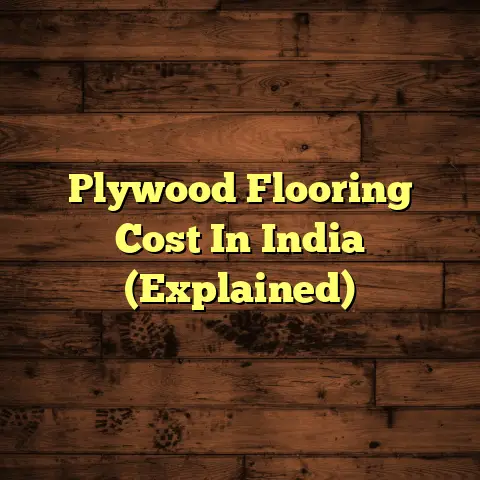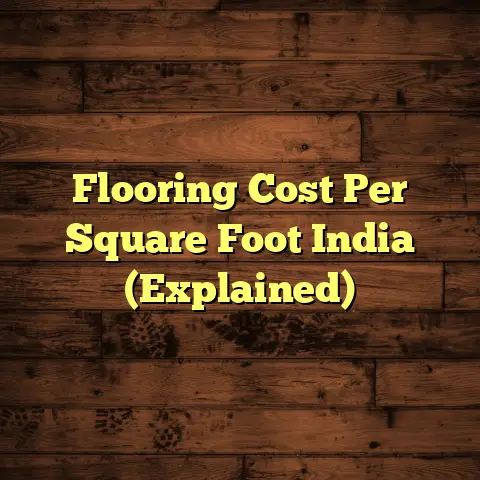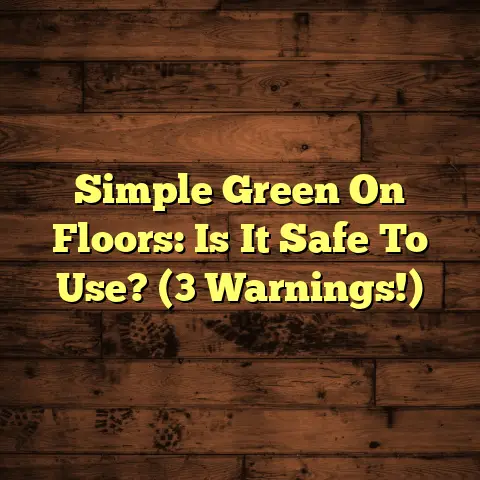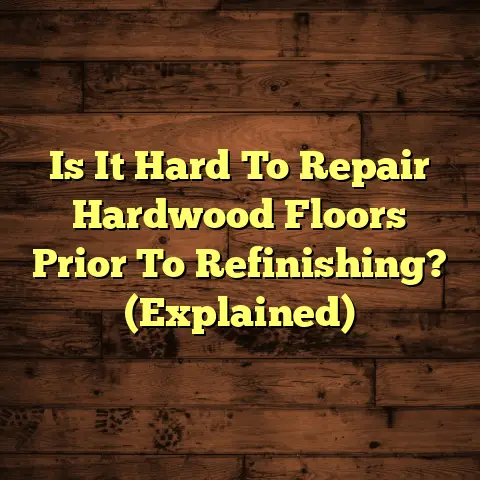Is Vinyl Floor Waterproof? (Explained)
When you’re in the flooring business, wear-and-tear is something I see daily.
Whether it’s a busy family home or a high-traffic commercial space, flooring takes a beating.
One type of flooring that has gained popularity in recent years is vinyl, particularly for its durability and resilience.
But a common question arises: Is vinyl floor waterproof? Let me share my insights and experiences.
The Story Behind Vinyl Flooring
I remember the first time I installed vinyl flooring in a client’s kitchen.
The previous floors had suffered from water damage, leading to warped wood and unsightly stains.
My client wanted something that could withstand spills and the inevitable mess that comes with cooking.
After researching the options, I decided vinyl was the way to go.
Vinyl floors are typically made from PVC (polyvinyl chloride), a synthetic plastic.
This material is known for its water resistance, making it an excellent choice for areas prone to moisture, like kitchens and bathrooms.
However, it’s important to understand that not all vinyl flooring is created equal.
My Journey into the World of Vinyl
As I started my career, I experimented with various flooring materials.
Each one taught me valuable lessons, but vinyl stood out for its versatility and affordability.
One project that particularly impacted my perception involved a family with young children and pets.
They needed a flooring solution that could handle spills, scratches, and the occasional muddy paw print.
During our consultation, I showed them samples of vinyl flooring, explaining how it could mimic the look of hardwood while offering better resistance to water and dirt.
The family decided on a luxury vinyl plank (LVP) that resembled oak wood.
They were thrilled with the choice, and I was excited to see how it would perform.
Types of Vinyl Flooring
There are several types of vinyl flooring available today:
- Vinyl Sheets: These come in large rolls and can cover an entire room without seams.
They are highly resistant to water but can be challenging to install if you’re not experienced. - Vinyl Tiles: These are square tiles that can mimic the look of stone or ceramic.
They’re easy to install and replace, but the seams can be more vulnerable to moisture if not sealed properly. - Luxury Vinyl Plank (LVP): This is my personal favorite.
LVP looks like hardwood but offers better moisture resistance.
It’s ideal for clients looking for a stylish yet practical option.
My Experience with Installation
During one project, I installed LVP in a client’s basement.
The area was notorious for dampness, and I knew we needed to ensure a solid installation to prevent any issues down the line.
To begin, I checked the subfloor for moisture levels using a moisture meter—this step can save you from future headaches.
After ensuring the subfloor was dry, I used a high-quality underlayment specifically designed for moisture control.
This added an extra layer of protection against any potential water damage.
The installation went smoothly, and my client loved the final look!
Is Vinyl Flooring Waterproof?
Now, back to the main question: is vinyl flooring waterproof?
Generally speaking, most vinyl flooring options are highly water-resistant, but calling them completely waterproof can be misleading.
- Water-resistant means they can withstand spills and splashes without immediate damage.
- Waterproof implies that they can handle standing water without any risk of damage.
While LVP and vinyl sheets are excellent at resisting moisture, prolonged exposure to water can eventually lead to problems like mold or mildew in seams or underneath the flooring if moisture gets trapped.
Real-Life Challenges
During another project in a bathroom, I installed vinyl tiles.
Despite my best efforts to seal the seams, my client later reported water seeping in after a heavy shower.
While the tiles themselves remained intact, the underlying adhesive began to weaken.
This experience taught me the importance of proper sealing and maintenance.
Maintenance Tips
To keep your vinyl floors looking great and performing well over time, here are some tips based on my experiences:
- Regular Cleaning: Sweep or vacuum regularly to remove dirt and debris.
A damp mop with a mild cleaner works wonders for deeper cleaning. - Sealant Application: For tiles, consider applying a sealant around the seams to help prevent moisture from seeping through.
- Promptly Address Spills: Don’t let spills sit.
Wipe them up as soon as possible to avoid any potential issues. - Humidity Control: If you’re in a humid area, using a dehumidifier can help keep the environment stable and protect your flooring.
Cost Considerations with FloorTally
When planning a flooring project, cost estimation is crucial.
I often use FloorTally for this purpose.
It pulls local material and labor rates, allowing me to provide realistic budgets for my clients right from the start.
For example, during that basement renovation, I input all the details into FloorTally—dimensions, material choices, and labor costs.
The platform provided an accurate estimate of approximately $3,500 for materials and installation.
This transparency helped me build trust with my client as they appreciated knowing what to expect financially.
Comparing Vinyl with Other Options
In my experience, vinyl flooring compares favorably against other options like laminate or hardwood when it comes to water resistance:
- Laminate tends to be less water-resistant and can warp if exposed to excessive moisture.
- Hardwood, while beautiful, requires diligent maintenance to prevent damage from spills and humidity.
Vinyl stands out due to its resilience and ease of maintenance.
Installation Process
Let’s break down the installation process for vinyl flooring so you can get an idea of what to expect if you decide to go this route.
Preparation Steps
- Subfloor Inspection: Always check the condition of your subfloor first.
Look for any signs of moisture or damage.
If your subfloor is concrete, ensure it’s level and clean before proceeding. - Gathering Materials: Make sure you have all necessary materials on hand—vinyl planks or tiles, underlayment (if required), adhesives (for tiles), utility knife, measuring tape, and spacers for expansion gaps.
- Acclimation: Allow your vinyl planks or tiles to acclimate in the room where they’ll be installed for at least 48 hours before installation.
Installation Techniques
- Laying Out the Design: Before you start cutting or gluing anything down, lay out your planks or tiles in the desired pattern to visualize how it will look.
- Cutting Vinyl: Use a utility knife for cutting planks or tiles as needed.
Measure twice before cutting—you don’t want to waste materials! - Installing Planks: For LVP, use a click-lock method if available; simply snap the planks together according to manufacturer instructions.
- Rolling Out Sheets: If you’re working with vinyl sheets, roll them out into place, ensuring you overlap any seams correctly before cutting away excess material.
- Finishing Touches: Once everything is installed, trim any excess material along edges and install baseboards or quarter round for that polished look.
Post-Installation Care
After installation, avoid placing heavy furniture on the new floors for at least 48 hours to allow everything to settle properly.
Also, make sure your clients know how to care for their new floors—this will prolong their life significantly.
Challenges Faced in Vinyl Flooring Projects
While working with vinyl flooring has its perks, I’ve encountered challenges along the way that are worth mentioning:
Moisture Issues
One significant challenge arose during an installation at a rental property where tenants frequently reported leaks from plumbing issues above their unit.
No matter how well we sealed the seams of the vinyl tiles, there was always a risk of water seeping through if repairs weren’t made promptly.
Adhering Tiles Properly
Another project involved installing self-adhesive vinyl tiles in a laundry room.
Initially, everything looked great until humidity levels fluctuated drastically over time—some tiles began lifting at the edges due to poor adhesion caused by temperature changes.
I learned that using additional adhesive can help in high-humidity areas where self-adhesive options may not hold up well over time.
Unique Insights on Vinyl Flooring Durability
Through my work with various clients over the years, I’ve gathered unique insights about what makes vinyl flooring last longer:
- Quality Matters: Always opt for higher-quality products—even if they come at a higher price point—because they tend to offer better warranties and durability against wear-and-tear.
- Proper Underlayment: Investing in a good underlayment can make all the difference in sound insulation and moisture resistance.
- Environmental Factors: Be aware of your local climate conditions when selecting flooring materials; extreme temperatures or humidity can affect performance over time.
- Client Education: Take time during consultations to educate clients on maintenance practices; this will lead to fewer issues down the line!
Success Stories with Vinyl Flooring
Reflecting on my journey as a flooring contractor, I’ve had many success stories using vinyl flooring solutions:
Family-Friendly Homes
One notable project involved installing LVP in a busy family home with three active kids and two dogs!
The homeowners were thrilled with how easily they could clean up messes without worrying about damaging their floors.
They reported back months later about how well the floors held up against everything from juice spills to muddy paws—definitely a win-win situation!
Commercial Spaces
Another successful installation took place at a gym where high durability was essential due to foot traffic from members day in and day out!
We chose commercial-grade vinyl planks designed specifically for such environments; they offered excellent performance while maintaining aesthetic appeal.
The gym owners were ecstatic about how easy it was to maintain cleanliness across their facility—another success story!
Final Thoughts on Choosing Vinyl Flooring
Choosing the right flooring can feel overwhelming with so many options available.
If durability and water resistance are high on your list, vinyl could be your best bet—but remember that proper installation and maintenance are key factors in ensuring its longevity.
Reflecting on my journey as a flooring contractor, I appreciate the nuances each project presents.
From selecting materials to navigating client expectations, every experience enhances my understanding of what works best in different scenarios.
So, when you’re considering whether vinyl flooring is waterproof, remember: it’s highly resistant but not entirely immune to issues if neglected.
Always prioritize quality installation practices and take care of your floors—your future self will thank you!
Additionally, keep in mind that while vinyl offers many benefits over its counterparts like laminate or hardwood regarding moisture resistance—it doesn’t replace thorough research into specific products available on today’s market!
Investing time into understanding these factors will ultimately lead you toward making informed decisions tailored specifically toward your unique needs!





